new posts in all blogs
Viewing: Blog Posts Tagged with: book apps, Most Recent at Top [Help]
Results 1 - 21 of 21
How to use this Page
You are viewing the most recent posts tagged with the words: book apps in the JacketFlap blog reader. What is a tag? Think of a tag as a keyword or category label. Tags can both help you find posts on JacketFlap.com as well as provide an easy way for you to "remember" and classify posts for later recall. Try adding a tag yourself by clicking "Add a tag" below a post's header. Scroll down through the list of Recent Posts in the left column and click on a post title that sounds interesting. You can view all posts from a specific blog by clicking the Blog name in the right column, or you can click a 'More Posts from this Blog' link in any individual post.
Splashy news headlines can grab our attention, but it's crucial that we engage kids with deeper thinking about current events. Whether it's prompting dinner-table discussions or classroom debates, current events provide so many avenues for kids to question, think and discover. One of my favorite sources is
Newsela. Here are my top 5 reasons why I recommend Newsela for kids, teachers and families:
1. Engaging content, easy to searchNewsela consistently engages kids with its content. They have a terrific sense of what kids will be interested in and yet they never underestimate kids' ability to think about big issues. They balance fun articles (
Jedi lightsaber exercise class) with hard-hitting news (
Flint, Michigan water pollution crisis). And they use great photos to draw kids in.
It's easy to search for specific topics or browse general interest areas--and this encourages kids to figure out what interests them, to discover the news that matters. I also love that there's a dedicated site for elementary kids, recognizing that some articles are better for younger kids than others.
 |
| screenshot of "latest news" from Newsela 1.22.15 |
2. Adjustable reading levels for every articleKids can select the right reading level for them, adjusting the article with an easy click. Nonfiction is harder for many kids to read, especially current events about topics that are new to them.
Newsela lets kids read an article at an easier level, with simpler sentences and less complicated vocabulary. They can read, change the level and re-read the same article. Kids with different reading levels can read and discuss the same article but at a level just right for each kid.
 |
| Kids can easily adjust the reading level |
3. Easy ways to personalize & save contentWe all like personalizing our reading experience. Kids sign up for free Newsela accounts--at school, I recommend that they use their school Google account to automatically sign in.
Newsela lets readers mark which articles they like and recommends other articles on a similar subject.
Teachers love the annotation features. Kids can highlight and annotate articles, saving their thoughts for later. This makes it great for prompting deeper thinking, discussions and further writing about articles. This feature promotes active reading, helping kids focus on main ideas and engage with the material. It's so easy to use that I have found kids enjoy it.
 |
| annotations made with a 5th grade class |
4. Quizzes help kids check understandingWhile I am not a fan of multiple-choice quizzes, I actually think these quizzes help kids check their understanding of the article. They also let kids practice taking this type of quiz in a low-stress environment. This helps them practice just the sorts of questions that will be on state tests, but helps them keep a growth mindset--noticing how they get better as they practice more.
5. Text sets encourage kids to broaden thinkingI love the way that Newsela editors are creating text sets to encourage kids to read more broadly. Some recent examples include text sets on
animal ethics,
bullying, and
pollution. Teachers will especially like the
PRO/CON text set to support students' persuasive writing.
Newsela AppAnd now, it's even easier to use at home with your mobile device--Newsela has just released its app for iPads and iPhones. See this
Newsela blog article for more information. I've only just started testing this, but I like it already. It's easy to check the most recent news, and it's also easy to search for specific topics. I love the way readers can easily change the reading level on the app -- very well designed.
If you're looking for a way to engage kids with the news, definitely check out Newsela. I'd recommend the Newsela Elementary site for grades 3-5, and the regular site for grades 6 and up. I have only used the free site, and I hope that it continues to provide robust access for general free users.
We use both the free and PRO site in our school district. My daughter's 6th grade teacher uses the PRO subscription site and really likes the additional data he gathers. For families and many classrooms, the free site is a terrific resource. If you make a purchase using the Amazon links on this site, a small portion goes to Great Kid Books. Thank you for your support.
©2016 Mary Ann Scheuer, Great Kid Books
My word of the week is “fantastical”…  Not sure why….maybe because it sounds like a Willy Wonka-type word! The official definition of “fantastic” is: conceived or appearing as if conceived by an unrestrained imagination. That exactly how I feel about my Weekend Links picks this week. Enjoy!
Not sure why….maybe because it sounds like a Willy Wonka-type word! The official definition of “fantastic” is: conceived or appearing as if conceived by an unrestrained imagination. That exactly how I feel about my Weekend Links picks this week. Enjoy!
Minds in Bloom: 6 Ways to Teach Kids about the World -a guest post from the wonderful Becky Morales of KidWorldCitizen.

The Children Shall Lead Us: Top 7 Children’s Books on Leadership for Social Justice
via @blackvoices

4 Early Chapter Book Giveaway! #ScholasticBranches via @PragmaticMom

Excellent Nonfiction Books To Get Kids Reading via @imagination soup

13 Children’s Books that Encourage Kids to Love Black Hair via @ForHarriet

Fantastical News
There are so many exciting things in the works right now. If you missed it, we recently did a special post on becoming an Author Sponsor for MCCBD 2016 AND we announced the opening of our Review Blogger Sign-up for MCCBD 2016 as well. Pass the word on both please!

But another thing we are tickled about is the fact that we have two powerhouse multicultural children’s book publishers joining us as Platinum Sponsors for 2016. Wisdom Tales Press is joining us for a 3rd year and newcomer Story Quest Books will be a crowd pleaser too.
Capstone Young Readers and Lee and Low and have stepped forward and filled out two of our Silver Sponsorship spots and we have quite a few awesome Author Sponsors as well so please take a peek. There are many Sponsorship opportunities still available (one Platinum left along with Gold, Silver and Bronze) so if you know of an author or publisher who would like to be part of the growing event, have them check out our Sponsorship Level page ASAP. The Early Bird Sale on the top three levels of Sponsorship ends 10/31/15.
Final Fantastical Thoughts: Here are a few of my “Fantastic” blog posts from the past!
The Fantastic Adventures of Krishna by Demi: In this elegant read, we ventured into the world and land of India, the God Krishna, and Hinduism in the book The Fantastic Adventures of Krishna by author/illustrator Demi.

The Fantastic Flying Books of Mr. Morris Lessmore harkens back to the days of silent films with the grander of those first technicolor movie classics such as the Wizard of Oz. Each page as a hidden piece of magic embedded to be discovered by those who journey through this soon to be classic. Something may look familiar to you during your time with this app and that is because of the brilliant work done by William Joyce.

Your Fantastic Elastic Brain is more than just an ebook for children, parents and educators…The app goes above and beyond the concept of a children’s book in digital format. Embedded lesson plans offer activities designed to build an understanding of neuroanatomy, the brain’s primary functions, and how to stretch and shape the brain to its full potential. I have a sneaking suspicion we could all use a refresher course in brain function, so parents and teachers might find this feature interesting as well… Go forth, young parents, and download.” ~ Leslie Rasimas, Appy Awards

Have a Fantastic week!
The post Weekend Links: Fantastical Reading Finds appeared first on Jump Into A Book.
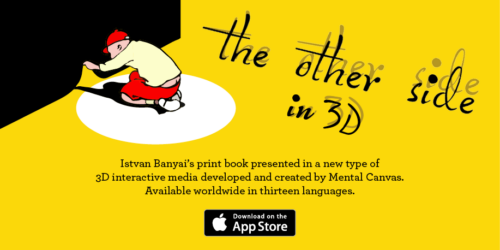
Foof! It’s been a while since I’ve done one of these so forgive me while I stretch the old app-reviewing little gray cells for a second.
There was a time, best beloved, when I thought this little blog would do it all. V-blogging. Podcasting. And, yes, app reviewing. But reviewing apps is an arduous process that takes an entirely different set of muscles than those used for book reviewing. Still, once in a while you encounter an app that speaks to you. Particularly if it is a very rare literary app for kids.
In the early days of apps, publishers were under the distinct impression that since they were new and cool, they’d provide a possible revenue stream. And so, for a little while, we saw a real plethora of lovely apps based on picture books. Freight Train by Donald Crews. How Rocket Learned to Read by Tad Hills. Wild About Books by Judy Sierra. That sort of thing. It didn’t take long before simple economics made it clear that apps don’t make much in the way of moolah. You invest a lot of money at the front end, but charge only scant amounts to the customers (I mean, seriously, who’s gonna buy a $10 app?). Over a very long period of time an app might make back its money, but that’s always assuming you aren’t producing a bunch of them at once.
The end result of all this was that the picture book apps we’ve been seeing over more recent years have been of an artistic bent. Rules of Summer by Shaun Tan (with music by Sxip Shirey!) or maybe The Numberlys by Bill Joyce (which is kind of a cheat to include since the app preceded the book, but you know what I mean).
Into this uncertain landscape steps Mental Canvas. Julie Dorsey, a Professor of Computer Science at Yale University, is the Founder and CEO of this relatively new software company. Funded by the National Science Foundation’s SBIR (Small Business Innovation Research Program), the company uses Dorsey’s visual computing specialty to develop “a new digital graphical media type that sits between a 2D drawing and a 3D model.”
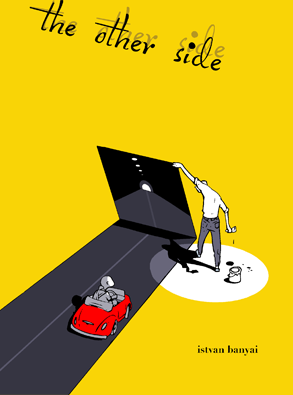 Come again? Well, honestly, the only real way to explain it is to see it. And the book that Mental Canvas decided to use to kick off a lot of what it’s doing was, of all things, Istvan Banyai’s The Other Side.
Come again? Well, honestly, the only real way to explain it is to see it. And the book that Mental Canvas decided to use to kick off a lot of what it’s doing was, of all things, Istvan Banyai’s The Other Side.
Children’s librarians who’ve been in the business since 2005, do you remember this book? It was one of the first I ever reviewed at old Amazon.com. One January 23, 2006 I wrote it up (marking it as one of the last pre-blog reviews I would write) and said that, “I’m not gonna tell you that every person and child you hand this to is gonna adore it. But for pure visual adrenaline, few things will entrance and entice you better than Banyai’s remarkable effort. A book that won’t make it easy for you. Your intelligence will just have to rise to its level.”
Forgotten in the wake of Banyai’s more popular Zoom and Re-Zoom, the book finds a new life in the form of an app for kids. And as it happens, I never would have considered it but The Other Side is rather ideal in an electronic format.
If you’re unfamiliar with the story, here’s the description I wrote of the book back in the day:
“You need to understand how to read this book before you pick it up. Fortunately, the instructions are in the title itself. Everything on one page corresponds to what happens on the next by showing the “other side”. Example: One page shows a boy in a coral colored cap peeking from an airplane window. Now turn the page and you find yourself on the other side of that window. You are now in the plane looking at the back of the boy’s head from down a row of passengers. A boy floating merrily in a swimming pool seems to be quite close to the fin of a shark. Turn the page and that shark is actually the point of his own black flipper and an underwater seascape is now the focus of your attention. The pictures are sometimes like conjurings from the mind of David Lynch. In one picture a single woman wearing a thin strapped shirt (of which Banyai has always been a big big fan) sits alone in an empty auditorium, a single spotlight on a face that peeks from the curtain. Sometimes the pictures are remarkable in their simplicity too. A yellow page with a white circle show a tiny point piercing through. Turn the page and there stands a baby chick with its beak poking into the white. Taken separately each picture is a story and a world in and of itself.”
If I can work at least one David Lynch reference into a picture book review, my job here is done.
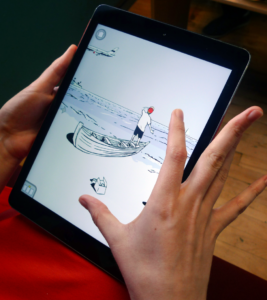 So how does the app work? Simple. The pages, for the most part, remain intact. Unlike some apps where pages are animated or include games in their crevices, there are only two things that Mental Canvas has done to distinguish these pages. First, they’ve rendered Banyai’s two-dimensional drawings in 3D. Turn your iPad around and you can almost see above and behind the subjects. Second, they’ve done a bloody good job at incorporating sound into the design. From car engines to street noises, the inside white noise of an airplane to the sound snow makes when you compact it with your feet, the audio design is king here. The underwater scenes alone will give swimmers a kind of sense memory little heard in app technology.
So how does the app work? Simple. The pages, for the most part, remain intact. Unlike some apps where pages are animated or include games in their crevices, there are only two things that Mental Canvas has done to distinguish these pages. First, they’ve rendered Banyai’s two-dimensional drawings in 3D. Turn your iPad around and you can almost see above and behind the subjects. Second, they’ve done a bloody good job at incorporating sound into the design. From car engines to street noises, the inside white noise of an airplane to the sound snow makes when you compact it with your feet, the audio design is king here. The underwater scenes alone will give swimmers a kind of sense memory little heard in app technology.
Some apps can be handed to a child while the adult walks away to, oh I dunno, cook dinner (not that I’d have any experience with that or anything). Other apps demand parent/child interactions. The Other Side falls squarely in the latter camp. Like its book before it, a lot of questions need to be asked as you read through. Where is the book going to take you next? Did you catch the connecting picture from the previous scene? Do you think this is what’s really on the other side of that cage?
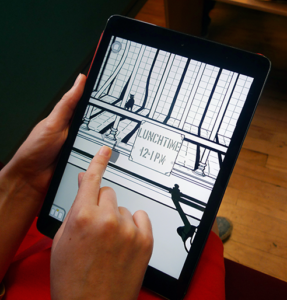 There’s isn’t much to it beyond the book, which is a novelty in some ways. When apps are expected to shove in as many bells and whistles as conceivable, the idea of simply presenting a book with a limited concept is . . . well, it’s rather original.
There’s isn’t much to it beyond the book, which is a novelty in some ways. When apps are expected to shove in as many bells and whistles as conceivable, the idea of simply presenting a book with a limited concept is . . . well, it’s rather original.
Of the original book I pondered why it wasn’t better known, writing, “The only thing I can figure at this point is that Banyai’s style, for all the critical praise and gushing adoration it receives, doesn’t connect to children particularly well. There’s certainly plenty to confuse them here. ‘The Other Side’ hasn’t any plot, but sometimes it seems as if characters carry over from scene to scene. There are also too many danged boys wearing caps. I’m not sure if you’re supposed to infer that they are all the same boy (even though some caps are the aforementioned coral and some are a bright eye-catching red).” I don’t know that many of my points have changed with the release of the app. However, I do think that children that might have eschewed it for easier fare could be more inclined to delve into it more deeply with the app as an aide. They’d be older kids, sure, but there’s nothing wrong with handing older kids wordless picture books. Particularly when they’re brain benders like this one.
In a way, Mental Canvas is using The Other Side to draw attention to their ability to render already existing art three-dimensional. It’s unlikely that they’ll adapt Zoom and Re-Zoom next (though clearly that would be the logical next step). In the meantime, for folks looking for another picture book app that isn’t the same old, same old, Banyai may have your ticket. Pick up the app and pick up the book in a local library while you’re at it. Definitely one wild and crazy ride, no matter how many dimensions you read it in.
See more information here.

The question came to me and I admit I was a bit stumped at first. A colleague was looking for recommendations of the best literary apps for kids. Put another way, apps with a distinct tie-in to specific children’s books. So I thought about it. I’ve toyed about with several apps for years. I could make such a list.
However, before I present it to you, I would like to point out that literary apps are in significant decline. When first they hit the scene they were prevalent because they were novel. However, publishers were quick to notice that from an economic standpoint they don’t really make a lot of sense. The amount of time and money you pour into an app is incongruous with how much one is allowed to then charge the consumer. It can take years for apps to break even, and ours is not a society where such slow money is seen as desirable. So while I don’t think apps will ever go away, literary apps will continue to be far and few between. The only ones I’ve seen crop up in the last year or two are labors of love from creative personalities (Bill Joyce, Shaun Tan, etc.).
Also please note that this list is NOT particularly good at listing nonfiction tie-in apps. There are, I know all too well, some fantastic ones out there. However, aside from the Barefoot Book World Atlas, I haven’t had much contact with them.
And now, the hits!
Animalia by Graeme Base – Allows the reader the chance to turn a simple reading of the book into a game.
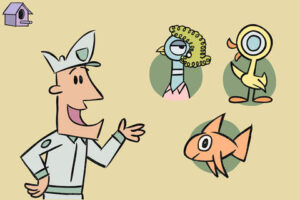 The Barefoot Books World Atlas by Nick Crane – Absolutely jaw-dropping. A must-have for any child over the age of four. Allows the viewer to zero in on different parts of the globe and learn learn learn.
The Barefoot Books World Atlas by Nick Crane – Absolutely jaw-dropping. A must-have for any child over the age of four. Allows the viewer to zero in on different parts of the globe and learn learn learn.
Don’t Let the Pigeon Run This App by Mo Willems – I’m sort of cheating by putting this here since technically it’s based on a children’s book character rather than a specific title, but when it’s the pigeon, honestly who cares?
Dr. Seuss’s ABC by Dr. Seuss – Pretty basic, but I like a lot of what it does. Reads the story straight through but allows the reader to hear individual words defined. Plus I like how it handles the many mumbling mice in the moonlight. Mighty nice!
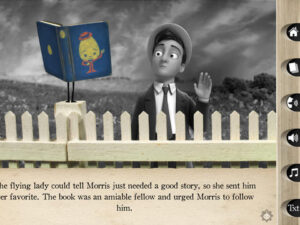 The Fantastic Flying Books of Mr. Morris Lessmore by William Joyce – The rare case where there was first an app, then a short film, and finally a book. I don’t know how well this one holds up in terms of rereading, but it’s the closest thing I’ve seen to a film in a book app form.
The Fantastic Flying Books of Mr. Morris Lessmore by William Joyce – The rare case where there was first an app, then a short film, and finally a book. I don’t know how well this one holds up in terms of rereading, but it’s the closest thing I’ve seen to a film in a book app form.
Freight Train by Donald Crews – This may be the earliest book related app out there. It used public domain music and was originally designed for phones. When the iPad was introduced it had to undergo a change, and remains somewhat pixelated as a result. That said, it’s still a beautiful piece.
The Going to Bed Book by Sandra Boynton – Boynton books make for difficult book-to-app transitions since there’s not much too them to begin with. This one relies heavily on a good narrator and small interactive options. I don’t know that a kid would turn to it over and over, but it’s not a bad app for the little bitty guys.
How Rocket Learned to Read by Tad Hills – A great book to begin with, the app reads the book straight, but also contains interactive elements that don’t distract from the storyline. A difficult balance to strike.
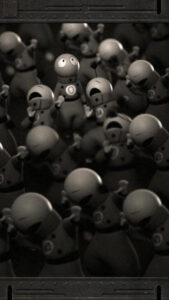 The Monster at the End of This Book by Jon Stone – Remarkably good. Truth be told, Sesame Street has almost never been good at books. Stone’s classic is the sole exception, and the app they made for it is stellar. Though Grover is not voiced by Frank Oz, you’d never be able to tell. The imitation is dead on. All the interactive elements work beautifully. Kids can read this over and over and never get bored.
The Monster at the End of This Book by Jon Stone – Remarkably good. Truth be told, Sesame Street has almost never been good at books. Stone’s classic is the sole exception, and the app they made for it is stellar. Though Grover is not voiced by Frank Oz, you’d never be able to tell. The imitation is dead on. All the interactive elements work beautifully. Kids can read this over and over and never get bored.
The Numberlys by William Joyce – Joyce remains the king of the app-turned-book. Again, this was an app first, a book second. I doubt anyone minds.
Pat the Bunny by Dorothy Kunhardt – When I first saw Random House premiere this app they acknowledged openly that a Pat the Bunny app is an inherently ridiculous concept. That said, it’s a very good one for the younger ages.
Press Here by Herve Tullet – Also a bit of a cheat since at no point does the book appear. Then again, the book itself was a sort of anti-app, so what you’ll find here makes quite a bit of sense in retrospect.
The Rules of Summer by Shaun Tan – Tan bears a lot of similarities to Bill Joyce in terms of his love of apps, cinema, and books (not necessarily in that order). He employed some truly lovely musicians when he worked on this one.
The Story of the Three Little Pigs by L. Leslie Brooke – Also a book meant to look like a pop-up but in this case the reader is allowed to see how the inner gears of such a pop-up might work. It’s actually really quite cool to watch.
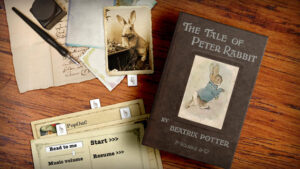 The Tale of Peter Rabbit by Beatrix Potter – You’ll actually want the one called PopOut! Peter. There is also a similar Benjamin Bunny app that makes for a good follow-up. It’s just one of the most beautiful I’ve ever encountered. It makes a great deal of effort to resemble an interactive book down to the silken ribbon there to hold your place. A masterpiece.
The Tale of Peter Rabbit by Beatrix Potter – You’ll actually want the one called PopOut! Peter. There is also a similar Benjamin Bunny app that makes for a good follow-up. It’s just one of the most beautiful I’ve ever encountered. It makes a great deal of effort to resemble an interactive book down to the silken ribbon there to hold your place. A masterpiece.
Wild About Books by Judy Sierra – The designers did a very clever thing here when they found a way to allow the reader to tilt the screen so that you can see around and behind the characters and set pieces.
See a gaping hole in the list? Tell me about it!


By: JOANNA MARPLE,
on 2/4/2015
Blog:
Miss Marple's Musings
(
Login to Add to MyJacketFlap)
JacketFlap tags:
Interview,
children's books,
non fiction,
picture books,
Roxie Munro,
Illustrators,
The New Yorker,
Illustrator interview,
book apps,
Bo Saunders,
Kiwi Books,
OCG Studios,
Roxie’s a-MAZE-ing Vacation Adventure,
Roxie’s Doors,
Roxie’s Puzzle Adventure,
The Inside Out Book of Texas,
The Inside-Outside Book of New York City,
Add a tag
Roxie was one of the very first kid lit people to welcome me to New York in 2012. I have visited her in her home and lovely studio here in New York City. Roxie is the author/illustrator of more than 35 … Continue reading →
Today, I'd like to share a guest review by Emily S., age 10, also known as my youngest daughter. This week, she read Love, The App, winner of the 2014 BolognaRagazzi Digital Award for fiction.
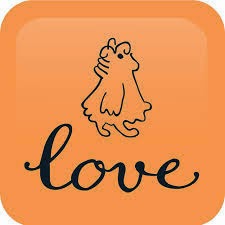 Love, The App
Love, The App
developed by Niño Studio
based on the book by Gian Berto Vanni
ages 6-12
review by Emily S., age 10
I just read the book app
Love and I think that it is amazing. Why I think that because I love how the company that made the app have a lot of interactive features but not too much interactive items that the reader wouldn’t get distracted from the book.
This book app is about a girl who gets taken to an orphanage because her parents left and she has no relatives. And when she goes to the orphanage none of the other kids play with her just because she is ugly. But one day the manager of the orphanage almost kicks her out of the orphanage. |
| She didn't have any relatives. |
I also really like the layout of this book app especially because of the transitions. Why I love the transitions of this book app is because you have to figure out how to turn the page, you don’t just swipe your finger and it turns the the page, you have to tap certain objects or you have to swipe the flaps in.
I think that the moral of the story is that even if someone looks different it doesn’t mean that they don’t have a kind heart or that they don’t deserve friends. And that you should always treat people the way you want to be treated.
In conclusion I think
Love is a great book app because it is a great story,it has interactive features, and it has a great moral too. This book app is great for all ages (even grownups!). Why this book is for all ages is because it is heartfelt, interactive, and it has a great story structure.
Do you want to learn more? Watch this video trailer:
Thanks, Emily! I really enjoyed hearing your thoughts on this. It's especially interesting how much you enjoyed having to "figure out how to turn the page". I agree that the moral of the story really shines through in this story.
The review copy of the app came from our home library. We purchased it after reading about the BolognaRagazzi Digital Awards in the excellent journal
Children's Technology Review.
©2014 Mary Ann Scheuer, Great Kid Books

By:
Jen Robinson,
on 1/1/2014
Blog:
Jen Robinson
(
Login to Add to MyJacketFlap)
JacketFlap tags:
book apps,
Awards,
cybils,
graphic novels,
poetry,
fiction,
book awards,
nonfiction,
children's literature,
Newsletter,
Add a tag
 As I promised yesterday, the 2013 Cybils shortlists have been announced, and they are fabulous. Cybils Editor-in-Chief Anne Levy says:
As I promised yesterday, the 2013 Cybils shortlists have been announced, and they are fabulous. Cybils Editor-in-Chief Anne Levy says:
"Happy Cybils New Year! Really, when all the confetti is swept up, the champagne bottles put in recycling, and your hangover nursed back to a semblance of sobriety, what else is there? Us, that's what!
We're back again with another list of books that kept our panelists riveted through the holiday season. We sifted through more than 1,300 books and apps this year. Phew! We have this down to a science by now, but even so, there have been a few changes." (Click through for more detail about the changes, and trends we've observed in this year's crop of finalists)
Some highlights for me:

 The Fiction Picture Books list includes 3 of my favorites: Mr. Tiger Goes Wild, Open this Little Book, and Sophie's Squash (links go to my reviews). Kinda glad I'm not on the Round 2 panel that has to select between those and several other well-regarded titles. But one day, I would like to be a Round 1 judge again in this category. So many wonderful books.
The Fiction Picture Books list includes 3 of my favorites: Mr. Tiger Goes Wild, Open this Little Book, and Sophie's Squash (links go to my reviews). Kinda glad I'm not on the Round 2 panel that has to select between those and several other well-regarded titles. But one day, I would like to be a Round 1 judge again in this category. So many wonderful books.

 Penny and Her Marble on the Easy Readers shortlist (how have I not reviewed this one?). With, of course, an Elephant & Piggie title, and several others that I look forward to checking out with my daughter. I see this category becoming increasingly important for reading suggestions for my household in the next couple of years, along with the Early Chapter Books category.
Penny and Her Marble on the Easy Readers shortlist (how have I not reviewed this one?). With, of course, an Elephant & Piggie title, and several others that I look forward to checking out with my daughter. I see this category becoming increasingly important for reading suggestions for my household in the next couple of years, along with the Early Chapter Books category.

 Escape from Mr. Lemoncello's Library and The 14 Fibs of Gregory K on the Middle Grade Fiction shortlist. I'm extra-happy for Gregory K author Greg Pincus, who is a real-world friend.
Escape from Mr. Lemoncello's Library and The 14 Fibs of Gregory K on the Middle Grade Fiction shortlist. I'm extra-happy for Gregory K author Greg Pincus, who is a real-world friend.
The Young Adult Speculative Fiction list is chock full of books that I've been wanting to read, and one that I did read and enjoy: Dark Triumph from the His Fair Assassin series.
But really, all of the lists are amazing. Need recommendations for nonfiction? YA graphic novels? Poetry? Book apps? The Cybils organization has your back. But don't take my word for it. Click through and see. You won't be disappointed. Happy New Year and Happy Cybils Day!
© 2013 by Jennifer Robinson of Jen Robinson's Book Page. All rights reserved. You can also follow me @JensBookPage or at my Growing Bookworms page on Facebook. This site is an Amazon affiliate.

As readers of my site know, I have been fascinated by multimedia book apps since the launch of the iPad and the first interactive books apps in 2011. I remember first reading the
Pop-out Peter Rabbit that spring, and then
The Fantastic Flying Books of Mr. Morris Lessmore in the summer of 2011. I was drawn into these apps by the way they combined the visual delights of picture books with the magic of audiobooks. They had a bit of the allure of the movies, and yet book apps put the readers firmly in charge of the pacing -- pulling the reader in to turn pages, discover hotspots and interact with the story.

Perhaps it is my perspective as a children’s librarian that draws me to the story aspect of book apps more than the interactive features, but I firmly believe that it is this sense of story, along with the interactive features, that draws children back to apps again and again. After all, if children just wanted interactive features, they would choose games like Angry Birds. Children really do love stories and the magical world that stories create for us in our minds, and this is just as true for book apps as it is for printed books. To paraphrase Martha Parravano, a book app might be an intangible piece of computer software, but at its heart a book app is an experience that unfolds for a child as they are reading it (
Sutton and Parravano, 2010).
But the question remains: How can we apply what we know already to evaluating this new media? Because book apps combine so many different elements, we need to draw on our knowledge of children’s books, learning theories, and online or multimedia teaching to understand how we as librarians can review book apps, what features we might consider, and why.
If you're interested in the different aspects I consider when I evaluate a book app, please take a look at my article
Book Apps as a New Interactive Learning Experience: Evaluating and Reviewing This New Media, published in the recent
CSLA Journal from the California School Librarians Association. The Spring 2013 issue of the CSLA Journal focuses on new media, and I was very happy to contribute my experience with book apps.
I am also excited for the work of the
AASL Best Apps for Teaching and Learning task force to be announced next month at the ALA Annual Conference. Our committee has been working hard to select the top 25 apps for teaching and learning, and we have a great selection to share at the conference.
I value the work of my local, statewide and national librarian organizations in supporting my professional development. These communities of engaged professionals help further my own thinking, provide thoughtful sounding boards when I am struggling with my own work, and encourage me to grow in new ways.
I would like to thank Jeanne Nelson, editor of the CSLA Journal, for her guidance writing this article. I would also like to express my sincere appreciation for
Michelle Holschuh Simmons, professor of library sciences at San Jose State University. Much of my original thinking was developed in her class on information literacy.
©2013 Mary Ann Scheuer, Great Kid Books
Time Magazine recently published an article "Fifty must-have iPad apps". I know that I usually write about books and apps to share with children, but today I'd like to share apps that I am finding myself using to conduct my professional life. I am actually finding that tweens and teens are starting to use these apps as well.
Check out the link to the article for the
full list. Here I am going to share 5 apps I've been using regularly that are on their list, and 5 apps I plan on checking out soon.
Five essential apps I've loved using:
- Dropbox: I use this constantly to access documents on the go, to backup and store files, and to share documents with others. Great, smooth interface.
- Feedly: I have switched all my blog reading over to Feedly and am loving the iPad app. In fact, I'm reading more blogs than ever now with Feedly. Love it!
- Flipboard: I used Flipboard more before I started using Feedly, but I still switch over to it for accessing Twitter and other news in a visual way. I'm intrigued by SLJ's Digital Shift article on using Flipboard for students to create their own customized, curated digital magazines.
- Paper: This app lets me doodle, draw and brainstorm in such a creative, intuitive, beautiful way! I just love it. Travis Jonker of 100 Scope Notes first turned me onto Paper, and then it was recognized by Apple as the App of the Year.
- Waze: This traffic app helped us navigate our way through LA traffic maze last summer - with my 13 year old navigating and me at the wheel! Waze identifies optimal routes, taking into account traffic, hazards, and blockages as well as simple navigation.

Five apps I want to check out:
- Blogsy: I have not written blog posts on my iPad yet. I'm wondering if any blogging friends have done this much. Every time I try, I find it clunky and difficult. Hoping that Blogsy has a better interface!
- Comics: Love my first look at this interface. I'm curious to see if this app has many comics for kids.
- Newsy: I'm interested in Newsy's video approach, and want to see if it's sensationalized or straightforward. Time writes that it "features professional anchors who deliver the news in easy-to-digest, no-fluff snippets," which sounds good to me.
- Pinnacle Studio: I'm interested in moving toward video editing on the iPad. I love taking videos of student performances using the iPad, and am curious whether this app can give me similar control and options as a desktop video editing tool like iMovie.
- Tweetbot: I use Twitter throughout my day for professional connections, resources and learning opportunities. I'm curious to see if Tweetbot provides a more streamlined, reliable app than the Twitter app.
What apps do you consider essential for your professional and personal learning? Do you see kids starting to use these? Are there any you'd add to Time's list?
I've loved being part of the American Association of School Librarian's task force choosing the
Best Apps for Teaching and Learning. I can't wait to share our recommended list this June at the ALA Annual Conference!
Today is St. George’s Day, the patron saint of England, and it’s the day we traditionally celebrate Shakespeare’s birthday (see a timeline at Mr. William Shakespeare). I've been looking forward to reading Touch Press's fantastic app The Sonnets by William Shakespeare, and I snapped it up today when I saw it on sale. I want to share this wonderful enhanced, multimedia experience that provides both artistic enjoyment of classic literature and increased academic understanding of complex text.
 The Sonnets by William Shakespeare
The Sonnets by William Shakespeare
developed by Touch Press
version 1.0, 2012
available on the iTunes AppStore
Touch Press writes that "
The Sonnets by William Shakespeare allows you to enjoy, explore and understand these immortal works of literature as never before." While that seems like hyperbole (as never before?), I am truly amazed at the rich experience that reading this app brings.
This app brings together dramatic performances of Shakespeare's 154 sonnets with the annotated, unabridged text and critical essays. Students can watch professional actors ranging from Patrick Stewart to Kim Cattrall recite the sonnets - an inspiring experience on its own. But you can also switch over to reading the poems while you listen to the professional reading, with lines highlighted as you go. Just watch David Tennant's performance of the famous Sonnet 18: "Shall I compare thee to a summer's day?"
The actors' readings bring me so much greater appreciation for these poems than simply reading the text by itself. I also love the way that Touch Press brought so many different actors to this project, providing readers with the sense that we all can connect with Shakespeare's works in different ways.
The academic notes and videos also provide many different ways in for readers, reinforcing the idea that there is no one correct interpretation of these poems. Since I was reading more for my own pleasure, I was drawn to the video interviews with different academics and professionals. It was fascinating to hear different opinions on the same topic, giving me insight into the range of debates that still surround these poems. For example, I never realized that we don't exactly know whom the Sonnets are written for or to. Students will also find the line by line annotations helpful.
Throughout, Touch Press marries the text and the narration, the artistic and the academic, the visual and the auditory -- providing a seamless, multi-layered, multi-media reading experience. Overall, this is an app that I will come back to again and again. Get this for students who are auditory learners, but also get this for friends who love listening to poetry or learning about Shakespeare's plays.
For more information, see the
Touch Press website:
The Sonnets by William Shakespeare. For more reviews, see:
School Library Journal,
The Guardian newspaper, and
The Independent newspaper.
I purchased the review copy for my own home library. If you make a purchase using the Amazon links on this site, a small portion goes to Great Kid Books (at no cost to you!). Thank you for your support.
Review ©2013 Mary Ann Scheuer, Great Kid Books
"Oh Romeo, Romeo! Wherefore art thou Romeo?"
Do these lines stir passion and longing as you hear Juliet's words? Or do they make you squirm and recall agonizing afternoons trying to slog through Shakespeare plays line by line? Students continue to read Shakespeare's many plays, memorizing passages, learning how to closely read text for themes and character development, and trying to decipher 16th century idioms.
Two interesting apps are now available that can help students access and appreciate Shakespeare plays. I would like to share two that I've explored for Romeo and Juliet: one from
Shakespeare in Bits and and another from Cambridge University Press. Both apps let students listen to a full cast production of the play while they read along, and let students explore a vast amount of resources to help them understand the play.
 Romeo and Juliet
Romeo and Juliet
Shakespeare in Bits
developed by MindConnex
available on the iTunes app store as a standalone app and in the Shakespeare in Bits universal app
ages 12 - 16
The Shakespeare in Bits app will appeal to students who want a visual sense of the story as they listen and read the play. This app combines an excellent full cast narration of the fully play with a rudimentary animated version enacted on half the iPad screen, while the full text of the play is on the other half. While it sounds cluttered, the design works very smoothly. Each scene is broken into manageable chunks, helping students absorb the original language. I found that students were able to process the meaning of the play more as they read, watched and listened to a scene.
I was particularly impressed by the supporting materials that Shakespeare in Bits provided to help students read Romeo and Juliet. Tap highlighted words, and see them change in the text to more common, modern language. Tap the "L" next to the text and readers learn about the language choices Shakespeare made. In the example below, the note states,
"Notice the contrast in language between the two characters. Juliet begins by asking Romeo a direct question - how did he find her? But we know by now that Romeo never gives direct answers, and his response here is predictably flowery and evasive."
Sprinkled throughout are questions for students to think about. So this app does not always provide answers, but rather guides students to their own close reading of the play. Each section is also accompanied by notes and a synopsis, and readers have a place to make their own notes. I found that the notes were written in an accessible way, one that would help students reading on their own.
In addition, the app provides a guide for each character, summarizing the different characters' perspectives and roles in the story. Visual learners will certainly appreciate the character map showing the pictures of the main characters linked to one another, as their relationships are arranged.
Some might feel that the animations are too rudimentary, but I actually found their simplicity benefited me. The images were enough to ground the action of the play, but I was prompted to embellish them in my own mind's eye. They clearly aren't meant to be how the play would seem in real life. But they can provide a scaffolding for students.
My biggest concern with this app is that it provides too much for students. Will they use the short essays in the Analysis section to replace their own efforts writing analytical essays? Perhaps. But I think that Shakespeare calls for more support than less.
 Romeo and Juliet
Romeo and Juliet
published by Cambridge University Press
designed and developed by Agant Ltd.
available on the iTunes app store
ages 12 - 16
The apps developed by Cambridge University Press are also an excellent way to support students as they read and think about Shakespeare's plays. This app is perhaps more academic, and so may appeal to some students and teachers wanting something with more gravitas.
Interestingly, the Cambridge and the Shakespeare in Bits apps both use the same audio narration, a full cast recording produced by Naxos Audiobooks, starring Michael Sheen as Romeo and Kate Beckinsale as Juliet. The Cambridge app also allows readers to read along with the full play as they listen to the recording.
Readers control several features that support their reading. Standard and academic glossaries provide support for students translating sections to more accessible modern English, and academic notes providing literary and linguistic background. I particularly liked the scene synopses and detailed synopses that were embedded within the text like stage directions. These helped orient me as I started reading a section. Since the language of Shakespeare does not come naturally to our students, it is often helpful if they know what is going to happen before they read a scene. If readers find these distracting, they can easily turn them off.
Each scene also begins with a few photographs of live stage, television or movie productions of Romeo and Juliet. This gives students the tangible feeling that the play can be interpreted and staged in many different ways.
I found that this app preserved more of a sense of the play as an academic experience, read in a purer form instead of chunked and illustrated. The navigation and coordination of the audio to text are excellent. I can certainly see it appealing to teachers who want students to do more of the figuring out on their own.
I definitely recommend taking some time to explore the section "Examine", which includes clear short essays helping readers understand the characters, themes in the play, the history and choices made in staging performances, and Shakespeare's use of language, style and imagery.
My biggest concern with this app was that the supporting materials were not as accessible to middle school and high school students. Romeo and Juliet is often read by young teens as their first experience with Shakespeare (often in 7th grade). While I liked the circles of characters, I don't think these are as readily accessible to students without any visual support. The glossaries are not as intuitively supportive as the Shakespeare in Bits glossaries, but they provide more academic support for readers wishing to delve deeper.
This video gives a nice preview of the Cambridge app:
Read more about Cambridge University Press's Shakespeare apps in this article in the
Guardian, a British national newspaper:
Do Shakespeare plays smell as sweet when released as iPad apps?Whether you're a parent wanting to help your child experience Shakespeare, a teacher looking for new ways for students to read and think about these plays, or a librarian encouraging patrons to explore new apps, both of these platforms are definitely worth checking out. I know they would have made my experiences fuller and more enjoyable when I was in high school.
Review ©2013 Mary Ann Scheuer, Great Kid Books
Each year I turn to the
Cybils Awards to learn about books that kids are really going to like, and that are really well written. These awards specifically choose books that meet both criteria. As they write on the
Cybils website,
"If some la-di-dah awards can be compared to brussel sprouts, and other, more populist ones to gummy bears, we’re thinking more like organic chicken nuggets. We’re yummy and nutritious."
For the past two years, I have had the great honor of working with the Cybils team to organize the
Cybils Book App Awards. We have carefully considered over 80 nominated books apps, looking at storyline, interactive features, narration, illustrations, and overall child appeal. This award stands out for considering the literary merit of book apps, not just their technical achievements.
Today, the winning books are announced and I couldn't be happier! Our round 1 judges chose an excellent panel of finalists, and the round 2 judges agreed that one app rose to the top:
Dragon Brush
by Andy Hullinger and John Solimine
developed by Small Planet Digital
winner of the 2012 Cybils Book App Award
ages 4 - 8
available on iTunes
What would you paint if you had a magic paintbrush? Would you paint all the riches you might want? But what might happen if an evil lord tries to steal this away?
Dragon Brush takes children into this scene, using interactive features to draw children along but never overwhelming the story.
Dragon Brush embodies all that the Cybils stands for: an excellent story that draws children back to it again and again. Children are fascinated with the interactive features, revealing the intricate paintings that magically come to life, and finding each of the hidden inkpots.
I want to send a special thanks to our wonderful team of judges:
Alyson Beecher,
Sara Bryce,
Helen Dineen,
Carisa Kluver,
Elisabeth LeBris,
Lalitha Nataraj,
Cathy Potter,
Melissa Wiley and
Paula Willey. Each one added thoughtful comments and we all learned so much from one another. I feel lucky to have so many colleagues throughout the blogging world helping me explore this wonderful world of book apps.
All of the
Cybils winners are fantastic. Take some time to peruse this wonderful resource and find great books to share with your kids. Read about other book apps here on my blog,
Great Kid Books.
Some of the best interactive storybook apps show children that magical leap from the ordinary into a magical world. Dragon Brush, a finalist in the 2012 Cybils Book App Award, weaves a story based on a Chinese folktale that keeps children coming back to it again and again.
 Dragon Brush
Dragon Brush
by Andy Hullinger and John Solimine
developed by Small Planet Digital
2012 Cybils Book App Award finalist
ages 4 - 8
available on iTunes
What would you paint if you had a magic paintbrush? Would you paint all the riches you might want? But what might happen if an evil lord tries to steal this away?
Dragon Brush takes children into this scene, using interactive features to draw children along but never overwhelming the story.
As Cathy Potter, of
The Nonfiction Detectives, writes in her review of Dragon Brush for the Cybils,
An old woman gives young Bing-Wen a magic paintbrush made from a dragon’s whiskers in this imaginative original story. Bing-Wen uses the paintbrush to paint a chicken to provide food for his family, a tree to grow fruit for the village, and a comical dragon that isn’t very fierce.
Children will enjoy wiping their fingers across the screen to reveal intricate paintings that come to life. Readers will cheer when the clever Bing-Wen outwits the greedy emperor and teaches him a lesson. Soft guitar music, effective narration, kid-friendly illustrations, and bits of added humor bring a whimsical feeling to this app. A dragon, a greedy emperor, hidden inkpots, and artwork that comes to life…this is an app with kid appeal, for sure!
Dragon Brush embodies all that the Cybils stands for: an excellent story that draws children back to it again and again. Children are fascinated with the interactive features, revealing the intricate paintings that magically come to life, and finding each of the hidden inkpots.
But the story resonates with heart and kindness as Bing-Wen discovers the true gift of artwork - creating a gift for those you love. The artwork, narration and background music complement the story. The characters have a cartoon appeal but the style is restrained and appropriate to the folktale setting in ancient China. As you can see in the trailer, the music and narration by Mark Berninger and Aaron Dessner, of the band
The National, gives the app a soothing feel.
Enjoy this trailer for
Dragon Brush:
Dragon Brush from
Small Planet Digital on
Vimeo.
As Andy Hullinger writes on his website, "Sharing a story and bringing the images life with your imagination is a special kind of magic all its own. This is the heart of Dragon Brush, especially if you have an iPad. Be sure to try it together, With a little one snuggled next to you, mute the narration and read aloud for them as they touch and tap to move the story along." My only wish is that the authors provided a little more information about the folktale that inspired their story.
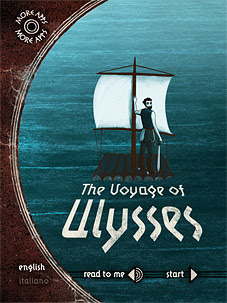 The Voyage of Ulysses, a gripping app for tweens based on Homer's classic Odyssey, is a finalist for the 2012 Cybils Book App Award.
The Voyage of Ulysses, a gripping app for tweens based on Homer's classic Odyssey, is a finalist for the 2012 Cybils Book App Award.
The Odyssey, Homer's classic tale of adventure, longing and struggle, is at once utterly gripping and hard to digest for many of today's children. I remember trying to teach this epic poem to a class of urban 9th graders - this hero's journey felt far away from their reality. The Voyage of Ulysses, a book app developed by the Italian company Elastico Srl, makes this classic story accessible for middle grade children while staying true to the original story.
With pathos and romance, the Odyssey is at once a gripping story and a fascinating look at how people long ago lived their lives. In twenty-four screens, mirroring the traditional 24 books of the Odyssey, this book app tells the story of Ulysses's ten-year travail on his way home from the Trojan War.
Spellbinding, slightly accented narration continues while we explore the delights of each page - arrows that rain from the ramparts of Troy, Greek warriors creeping from the giant horse and setting Troy ablaze, text that spins into the whirlpool Charybdis. Understated art, music, and sound effects match the lyrical, timeless style of the text, while pull-up sidebars provide even more information. A truly engaging app that also succeeds in communicating the themes of loneliness and exile that make Homer's epic emotionally arresting three thousand years later.

This is an excellent example of a book app for older readers that uses effective narration controlled interactive features to draw readers in. The distinct chapters kept the pacing of Ulysses' journey moving clearly toward his homecoming. The interactive features were enough to keep the reader engaged without ever taking them off-task or off-track. I loved the interactive map (on the right) that you could use to explore Ulysses' journey.
Enjoy a quick taste of the app in this book trailer / preview:
Share this book app with fans of the Percy Jackson series, Greek mythology and epic journeys. I hope this app reaches a wide audience in the US. So many of our stories continue to draw on Homer's quintessential hero's journey - we need to keep sharing it with children. This a fantastic example of an international app that appeals across cultures.
Review ©2013 Mary Ann Scheuer, Great Kid Books
.jpeg?picon=2320)
By: Mary Ann Scheuer,
on 1/1/2013
Blog:
Great Kid Books
(
Login to Add to MyJacketFlap)
JacketFlap tags:
picture books,
nonfiction,
ebooks,
animal stories,
preschool,
ages 8-12,
ages 5-8,
ages 2 - 4,
book apps,
Cybils 2012,
Add a tag
I am so excited to announce the finalists for the 2012 Cybils Book Apps Award. The Cybils Award recognizes books for children and young adults that combine both excellent literary quality and high kid appeal. I am honored to serve as the category organizer for the Book Apps category.
Here are this year's finalists for the 2012 Cybils Book Apps Award! Here is our full list of finalists, with links to the apps. This week I will share more about each of these apps. For a full description today, head over to the Cybils website.
Bats! Furry Fliers of the Nightwritten by Mary Kay Carson
developed by Bookerella and StoryWorldwide, 2012
nominated by
Cathy PotterDragon Brushcreated by John Solimine and Andy Hullinger
developed by Small Planet Digital
nominated by Aurora Celeste
Rounds: Franklin Frogwritten by Emma Tranter
illustrated by Barry Tranter
developed by Nosy Crow
nominated by
Danielle SmithThe Voyage of Ulyssesbased on the epic by Homer
developed by Elastic Srl
nominated by Viktor Sjöberg
Where Do Balloons Go? An Uplifting Storywritten by Jamie Lee Curtis
illustrated by Laura Cornell
developed by Auryn, Inc.
nominated by Teresa Garcia
Our fantastic team of judges debated long and thoughtfully to come up with this list of finalists. We evaluated over 80 book apps, ranging from picture books for the very youngest readers to nonfiction apps developed for young adults. We sought to highlight the full range of apps that are being produced, recognizing those that integrate text, illustrations, narration, animation and interactive features to produce an engaging reading experience.
I want to thank all of the round one Book App judges:
Cathy Potter,
Paula Willey,
Carisa Kluver and
Lalitha Nataraj. They all contributed so much, bringing different perspectives and experiences to our deliberations. I am so grateful for their time and thoughtful conversations about these apps. I am also so very grateful to the whole Cybils team for their support and exploration of this new way of sharing books with children. I hope you all enjoy these book apps with your children!
Head over to the
Cybils website to learn more about these five fantastic book apps for children. This week, I will share more about each one of them. Over the next six weeks, the fabulous round two judges will select one winner from these apps - to be announced on February 14th.
©2013 Mary Ann Scheuer, Great Kid Books
.jpeg?picon=2320)
By: Mary Ann Scheuer,
on 12/17/2012
Blog:
Great Kid Books
(
Login to Add to MyJacketFlap)
JacketFlap tags:
nonfiction,
ebooks,
books for boys,
ages 8-12,
ages 5-8,
ages 12+,
ages 2 - 4,
book apps,
Cybils 2012,
Add a tag
I am fascinated by the way that book apps can engage readers by integrating so many different ways of learning. You can look at vibrant photographs, manipulate charts and diagrams, watch videos, listen to narration and learn so much. I've been particularly happy to read several Nonfiction Book Apps during this Cybils season. Here are a few that really stand out to me:
Rounds: Franklin Frog
by Barry and Emma Tranter
developed by Nosy Crow
preview video
available on iTunes
ages 3 - 6
Young children love learning about the world around them. This app does a beautiful job introducing preschoolers and kindergartners to real facts about frogs, from their habitat to feeding to metamorphosis, through an appealing story about Franklin Frog and his offspring. It draws children into the story, as they guide the frogs with their fingers. Children make the frogs jump, swim, catch flies, avoid predators, find a place to hibernate, croak to attract a mate and more. This app always feels like an exploration of how a frog lives, and never feels like a game. As the
Horn Book review says, this app presents the information in "an accessible way that’s respectful of both its subject and its audience."
National Geographic Adventure Presents The Greatest Stories Ever Told
developed by National Geographic Society
preview video
available on iTunes
ages 9 - 14
Every time I read and explore this app, I am utterly amazed at the adventures these stories share. This app features five amazing stories ranging from mountain climbing in Yosemite to crossing the Antarctic by dogsled to climbing down into a volcano. Each story hooks readers with a short video, but then encourages them to read beyond this initial video to learn more. Text is interspersed with high quality photographs and interactive graphics. Readers scroll in different ways, vertically and horizontally - this keeps readers stimulated and engaged. The interactive graphics let you discover more - for example, a timeline with a sliding bar lets readers explore the different types of climbing gear used over the past 100 years. But most of all, I was impressed with the way readers got a sense of the real people involved through quotes, video and audio. It conveys a first-hand point of view in an exciting, engaging format.

 Wonders of Geology
Wonders of Geology
by Michael Collier
developed by Mikaya Press/Tasa Graphic Arts
a "Top 10 App" from School Library Journal
available on iTunes
ages 10 - 14
 The Wonders of Geology
The Wonders of Geology combines stunning photography, clear descriptions, and a combination of text and audio narration to teach tweens and teens about how the Earth's great mountains, valleys and other geological features were formed. Collier's breathtaking photographs draw readers in and convey a sense of awe at the wonders of these spectacular sites. The app switches between concise written paragraphs that introduce a subject and longer narrated segments as viewers look at photographs or diagrams. This helps tweens and teens who are curious about a topic but perhaps not determined enough to read in-depth nonfiction text to learn more about the subject. Collier shares his passion and in-depth knowledge of geology, as well as his stunning photographs. While some students may want more interactive features, I believe that others with an interest in the subject will be fascinated. It would make an excellent complement to a standard textbook for 6th graders studying Earth Science.
 |
| Animated diagram from Wonders of Geology |
Brian Cox's Wonders of the Universe
by Brian Cox
developed by Harper Collins UK and The Other Media
ages 16 to adult
available on iTunes
Particle physicist Brian Cox brings astrophysics to a general audience with the amazing
Wonders of the Universe app, bringing together his books
Wonders of the Solar System and
Wonders of the Universe with his award-winning TV series produced by the BBC. The app uses all of the features of the iPad, drawing readers in with personable, engaging video, clearly written text and interesting diagrams. The journey up from the smallest particles, past the moons and planets of the Solar System, out to the outer edges of the known universe truly blows my mind. I find myself in utter awe that scientists can understand, test and prove this knowledge. As The Other Media's managing director George Crabb says in a
Guardian article, "We threw out conventional thinking on multimedia experiences to instead come up with a revolutionary platform that can take complex narratives but deliver them with an intuitive clarity." This is an app for older high school students and adults who are fascinated by physics and astronomy, and who want to explore how multimedia technology can help us understand these subjects. I must admit that I do not understand all of what I am reading in this app, but I am fascinated nonetheless!
 |
| Wonders of the Universe combines text and video |
Nonfiction Book Apps show that this media has great potential for drawing readers into interesting topics. I am glad that several were nominated for the Cybils Award this year. Tune in on January 1st to the Cybils website to find out which apps are chosen for this year's shortlist.
The apps reviewed here came from both promotional codes sent by the developers and our school app library. The Berkeley Public Education Fund has graciously supported our school as we explore how apps help children learn and engage with a range of books.
Review ©2012 Mary Ann Scheuer, Great Kid Books

By:
Melissa Wiley,
on 10/15/2012
Blog:
Here in the Bonny Glen
(
Login to Add to MyJacketFlap)
JacketFlap tags:
Books,
Links,
reviews,
Cybils,
Little Nemo,
Google Doodle,
book apps,
Fox and Crow Are Not Friends,
The Prairie Thief,
Add a tag
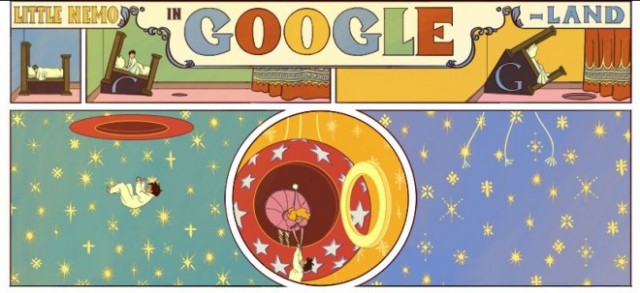
Today’s Google Doodle is a tribute to Little Nemo in Slumberland—one of their best Doodles ever, a tribute to Winsor McKay. Don’t miss it! And be sure to click the tabs. GeekMom has a nice post up with some background.
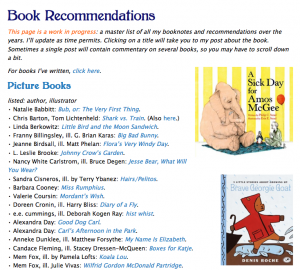 New Thicklebit! Me love that boy.
New Thicklebit! Me love that boy.
I worked alllllll weekend on the book recommendations master list, but I still have a long way to go. Happy with its progress, though!
Last day to nominate books and book apps for the CYBILs! The Book Apps team would especially appreciate your help—lots of great apps still waiting to be nominated.
Semicolon reviews The Prairie Thief: ”a delightful little tale.”
I also like the fact that this story for young readers doesn’t shy away from those wonderful, challenging vocabulary words that my young readers at any rate relished and gloried in. Ms. Wiley uses words like “obfuscating” and “predilection” and “amenities” and “laconically” just as handily and appropriately as she does the shorter, also vivid words like “pate” and “mite” and “frock”, all of which might enrich a child’s vocabulary as well as delight her mind.
(Amy at Hope Is the Word liked that part too.)
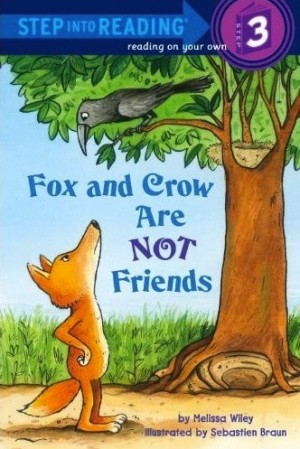 Fox and Crow Are Not Friends is reviewed in this month’s School Library Journal:
Fox and Crow Are Not Friends is reviewed in this month’s School Library Journal:
Children eager to move beyond easy readers and older students requiring simple text in a chapter-book format will find this title a good choice. As in many familiar folktale themes, Fox and Crow are trying to outwit each other….“That will teach you not to steal my cheese,” says Mama Bear, whose presence in the earlier chapters will be noted by astute observers of Braun’s lively, colorful cartoon-style illustrations. With its crisp writing and short sentences, this is a solid addition.
It also gets a mention in this SLJ piece: “Fresh and Fun Books for Emergent Readers“:
Melissa Wiley retells and expands upon an Aesop’s fable in Fox and Crow Are NOT Friends (Random House, 2012; Gr 1-3). Three entertaining chapters describe how these two enemies repeatedly—and humorously—try to outwit one another to earn bragging rights along with a tasty piece of cheese. Sebastien Braun clearly depicts the animals’ antics with lighthearted artwork in sherbet hues. The straightforward text, amusing illustrations, and hilarious rivalry will encourage developing readers to persevere.
More reviews here.
1) Thanks so much to everyone who turned out for the launch party on Saturday! I had massive amounts of fun. The Yellow Book Road was a perfect venue—what a gem of a store. San Diego-area folks, if you haven’t been down to Liberty Station to visit it, you really should make the trip. Lovely location and the kind of children’s bookshop you can fall into and never fall out. 
2) It’s CYBILs time again! The Children’s and Young Adult Bloggers Literary Awards public nomination period opens today. Visit the site for all the details and nominate your favorite kids’ and YA books and apps of the past year in a variety of categories. I’m serving as a Round 2 judge in the Book Apps category this year—looking forward to it! Would love to hear about your favorite book apps of the year, too. (One of the many wonderful things about the CYBILs is that all the judging panels are self-contained, so that you may serve on one panel even if you have books eligible in another, as long as you have no conflict of interest with the specific panel you’re on. Whew!) Nominations are open through Oct. 15. Check out the CYBILs sidebar to see what titles have already been nominated.
3) New Thicklebit today!
 The organizer for the Cybils Book App category, Mary Ann Scheuer, just posted a fabulous interview on her blog with William Joyce, author of The Fantastic Flying Books of Mr. Morris Lessmore. Mary Ann also shares a speech that William Joyce gave about his inspiration for the story, which is currently number one on the New York Times Bestselling Children's Picture Books list. The app version of the book was a shortlist title for the Cybils this year.
The organizer for the Cybils Book App category, Mary Ann Scheuer, just posted a fabulous interview on her blog with William Joyce, author of The Fantastic Flying Books of Mr. Morris Lessmore. Mary Ann also shares a speech that William Joyce gave about his inspiration for the story, which is currently number one on the New York Times Bestselling Children's Picture Books list. The app version of the book was a shortlist title for the Cybils this year.
Mary Ann says:
"I was so honored to be able to sit down with him and talk about the way new technologies like the iPad can be used to share stories with children.
Thank you to Bill Joyce, for sharing these stories with us and for taking the time to talk with me. Thank you to Simon and Schuster for arranging the interview. This interview was first shared on Katie Davis's fantastic podcast, Brain Burps About Books."
We hope that you'll take a few minutes to head over to Great Kid Books to listen.

By:
Betsy Bird,
on 7/4/2012
Blog:
A Fuse #8 Production
(
Login to Add to MyJacketFlap)
JacketFlap tags:
Crockett Johnson,
Fusenews,
Philip Nel,
book apps,
international children's books,
Kazakhstan,
Uncategorized,
t-shirts,
Ruth Krauss,
Syd Hoff,
apps,
Add a tag
 Okay! So I’m a little out of practice when it comes to these news items and looking at some of the stuff I’ve accumulated in the last month, a good swath of it is out of date. Here’s what I have that’s current then.
Okay! So I’m a little out of practice when it comes to these news items and looking at some of the stuff I’ve accumulated in the last month, a good swath of it is out of date. Here’s what I have that’s current then.
Not long ago the good people at the Women’s National Book Association called me up and wondered if I’d be willing to participate in a kind of panel discussion with some female children’s author/illustrators . . . from Kazakhstan. Twist! Naturally I said yes indeed. I mean, how often do you come across that kind of an offer? Publishing Perspectives wrote up the meeting here. No pictures of me except a nice glimpse of my left arm. Publishers Weekly also wrote it up here but my favorite recounting is from what must be a translated site at How to Be Published which refers to me as a “New York Public Library girl materials dilettante”. If I were a tattoo kind of gal, I would make that my standard.
- Two news items regarding good leftist cartoonists/children’s authors of the past. The first is this fine cartoon tribute to Syd Hoff in Tablet by Sarah Lazarovic. Thanks to Marjorie Ingall for that link. The second regards one Mr. Crockett Johnson. As you might recall he will be featured in a dual biography with Ruth Krauss by the multi-talented Phil Nel this coming fall. The magnificent title is Crockett Johnson and Ruth Krauss: How an Unlikely Couple Found Love, Dodged the FBI, and Transformed Children’s Literature. And then there’s the drop dead gorgeous book jacket by Chris Ware. Phil pointed out that not only is Ware drawing in the style of Crockett, he’s also doing a Sendak here, a Mary Blair there, etc. It’s also one of the sexier Ruth Krauss images I’ve seen. Cannot wait to get my grubby mitts on that one.

- Not a New Blog Alert BUT . . . it might as well be for all that I’ve paid attention to it. When I write a review on this site I puff myself a little and feel smart because I’m capable of linking to other reviews. Big whoop. When the good folks at The Classroom Bookshelf review a book they don’t just review it. They interview the author via video, provide countless useful links, and generally make the book as useful and accessible to teachers as humanly possible. It just puts me to shame. They’re off for the summer (teachers, y’know) but that doesn’t mean you can’t get a bit of jaw-dropping in by seeing what they accomplished so far. Dear Lord, I stand amazed.
- Some more me stuff. First a

By: Venetia Butterfield,
on 11/9/2010
Blog:
The Penguin Blog
(
Login to Add to MyJacketFlap)
JacketFlap tags:
design,
Web/Tech,
The Future,
Puffin,
Apple,
ebooks,
audio,
Apps,
e-Readers,
iPad,
iBooks,
book Apps,
eAudio,
puffin digital prize,
Add a tag
Today is an incredibly exciting day. Today is the launch of the Puffin Digital Prize and a brave new world for Puffin picture books. I'm so excited I can hardly breathe. But, I'm getting ahead of myself. Let me take a deep breath and I’ll explain things properly. I'll start at the very beginning . . .
As the Editorial Director of Puffin Picture Books, I am the lucky girl who has the privilege of working on beautifully illustrated, full colour books for young readers. Think Raymond Briggs and The Snowman, add Helen Oxenbury and Julia Donaldson and you get the picture. As I said, I am VERY lucky. But I wasn't feeling quite so lucky a little while ago, when the word digital was a real thorn in my side. How did picture books fit into this amazing digital world everyone was talking about? Well, quite simply, they didn't. Being full colour with integrated text, the technology simply didn't exist to bring them to life on a digital device. I would enviously look at my fiction colleagues with their e-readers where a whole world of stories lived and breathed in one nifty little machine. Sigh. All I could do was be patient. One day, I said to my beautiful, fully illustrated books, one day, your time will come. 
And come it did with a bang - the iPad. Woo-hoo! Like every other person at Penguin, I used all sorts of ruses, good and bad, to get my hands on one. And when I did it felt like Christmas. I've always been a
book-sniffer (I use that term affectionately, someone who loves a book for being a book as well as a fabulous story) but my conversion was complete in that one moment. Just look at what this thing can do! We have glorious technicolour in fanta








 Not sure why….maybe because it sounds like a Willy Wonka-type word! The official definition of “fantastic” is:
Not sure why….maybe because it sounds like a Willy Wonka-type word! The official definition of “fantastic” is: 


































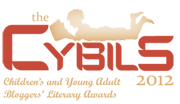
























Dear Zoo by Rod Campbell. There is also a lovely Miffy app for the iPad.
David Wiesner’s new app, Spot-On
Mo on the Go (much more interactive and fun than his first app) You can dance with Elephant and PIggie!
A few fabulous older book apps….
Heart in the Bottle by Oliver Jeffers (create your own drawing too!)
Tacky the Penguin (or any book app by Oceanhouse Media)
Press Here by Herve Tullet
Wild About Books by Judy Sierra
Big Nate by Lincoln Peirce (create your own comic!)
Non-Fiction book based apps-Both DK publishing and National Geographic have a great selection of apps for children. Also, Roxie Munro’s apps.
Betsy–If by “literary apps” you mean books that have been enhanced digitally in some way (animation, sound, etc) please know that these books need not be apps created at great expense and thus difficult to justify creating. With a little knowledge of css and html, picture book creators can add animation, narration, and sound to their ebooks without the necessity of hiring a developer. I hope you’ll download my ebook, Mother Nature Rhymes, from the iBookstore (it’s free!) and see what’s possible. Of course it’s only available on Apple devices now, but I’m certain that will change. And even granting that current limitation, there are enough iPads and iPad Minis (perfect size for kids) to make the effort worthwhile.
I wanted to include the David Wiesner but it isn’t a book yet, is it? I was mostly concentrating on the ones that were books first, apps second.
Good suggestions!
[...] What are the best Literary Apps for Kids? Via School Library Journal [...]
Thanks, great list!
Would you consider making a list of stories/literacy that did it the other way around: great apps first, print books later? Would be cool!
Oo. Neat notion. I’ll ponder it. Lots of great examples out there, that’s for sure.